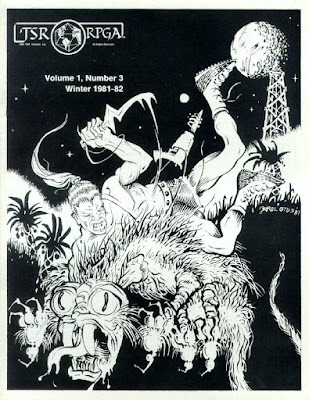Polyhedron: Issue #3
 Issue #3 of the technically-still-unnamed Polyhedron newsletter (Winter 1981–82) is notable for numerous reasons, starting with the absolutely gorgeous piece of Erol Otus Gamma World art that graces its cover. It's yet another glimpse of an alternate reality where TSR better supported its post-apocalyptic science fantasy game. Of course, the issue is filled with remarkable – and original – illustrations by TSR's stable of artists, so many, in fact, that I'll probably make another post highlighting some of them.
Issue #3 of the technically-still-unnamed Polyhedron newsletter (Winter 1981–82) is notable for numerous reasons, starting with the absolutely gorgeous piece of Erol Otus Gamma World art that graces its cover. It's yet another glimpse of an alternate reality where TSR better supported its post-apocalyptic science fantasy game. Of course, the issue is filled with remarkable – and original – illustrations by TSR's stable of artists, so many, in fact, that I'll probably make another post highlighting some of them.
The issue is double the size of the previous two issues (32 pages), though editor Frank Mentzer mentions that it will return to 16 pages with issue #4. The reason for that is, starting with that issue, the newsletter will appear bimonthly rather than quarterly. Mentzer also announces the establishment of a $1000 RPGA Scholarship Fund to the college-bound RPGA member "with the highest College Entrance Examination Board scores or equivalent thereof." Though I didn't subscribe to Polyhedron until a few issues later, I do remember the announcement of the winner of the scholarship each year.
Issue #3 sees the inauguration of Mentzer's "Where I'm Coming From" column, which he calls "my podium." This first installment isn't all that insightful. It's mostly a paean to the RPGA Network and thanks to readers for the warm response to the newsletter. "Dispel Confusion" continues, though it's no longer credited to a single TSR but simply to "The Game Wizards." As ever, it's an interesting look into the minds of the more rules-obsessed gamers of the early '80s. There's a question about surprise, for example, that brought to light the fact that, in by-the-book AD&D, each segment a character is surprised, he is subject to a full round's worth of attacks – up to five. I can honestly say I have never played the game this way nor have I ever seen anyone else do so, but then it's been long established on this blog that I frequently do it wrong. Oh well!
There is a massive – 7-page – interview with James Ward that is well worth discussing in its own right. Naturally, Ward has a lot to say about Gamma World, among other topics, which is what most interests me, given my lifelong fondness for the game. Dawn Patrol gets two articles devoted to it, the first of which is a report about the results of a tournament at the most recent GenCon. The article includes a turn-by-turn recap of a dogfight between five German and three American planes that ended in a German victory. The second article is another Dawn Patrol by Mike Carr, this time focusing on medals and commendations. Like Gamma World, Dawn Patrol is another game for which I have great fondness, but, unlike GW, I have not played it in decades. One of these years, I may have to fix that.
Don Turnbull's "Turnbull Talking" returns. He devotes himself to the question of just what hit points actually represent, a perennial topic of debate in the old days (and perhaps even nowadays, come to think of it). Michael W. Brunton's "Figure Painting" is just that, a three-page article about the ins and outs of painting figures for use with roleplaying games. Sadly, unlike similar articles in the pages of White Dwarf, no photographs accompany it, which makes the piece a lot less appealing to a painting-impaired reader like myself. Then we get three more pages of "Convention Wrapup," in which the events of GenCon XIV and GenCon East are reported. The focus is naturally on the results of the RPGA AD&D tournaments, as one might expect.
Merle Rasmussen announces a "Top Secret™ Gadget Contest." I'll be curious to see the results of the contest when they're revealed in a later issue. More immediately interesting is the piece of Erol Otus artwork that accompanies the article.
 The uncredited "Codebook" is a brief meditation on the use of codes and cyphers in RPGs, followed by four coded messages that are presented as part of a contest for readers to decipher. Later, there's also a Gamma World art contest – there sure are a lot of contests in this issue – in which readers are called upon to illustrate the monsters presented in issue #2 and in this issue. "Mutants: A Continued Sampling of the Weak Ones" by James Ward gives us four more opponents for use with the game. I was (and am) a sucker for stuff like this, so I was happy to see more of it here.
The uncredited "Codebook" is a brief meditation on the use of codes and cyphers in RPGs, followed by four coded messages that are presented as part of a contest for readers to decipher. Later, there's also a Gamma World art contest – there sure are a lot of contests in this issue – in which readers are called upon to illustrate the monsters presented in issue #2 and in this issue. "Mutants: A Continued Sampling of the Weak Ones" by James Ward gives us four more opponents for use with the game. I was (and am) a sucker for stuff like this, so I was happy to see more of it here.There are more reader-created tricks and traps in "Notes for the Dungeon Master," alongside "Notes from Overseas" by Don Turnbull. Also present is an uncredited full-page article "Spelling Bee" that looks at the use and abuse of the invisibility spell. "Saga of Marnie" by Marnie Bosch is a firsthand account of someone's experiences at GenCon East in July 1981. "Incomplete Convention Schedule '82" is simply a listing of gaming cons for the coming year. I was interested to see that Origins 82 was held in my old hometown of Baltimore that year. I never actually attended Origins until 1991, even though it was often held in and around Baltimore. What can I say? Cons were not a big part of my formative experiences in the hobby (and still aren't, though I should make a stronger effort to change that).
As I said at the beginning, issue #3 of Polyhedron is a significant one, demonstrating that it's already growing and changing in response to its increased readership. Having no direct experience with the RPGA itself, I can't help but wonder how successful it was during the first part of the 1980s. Certainly TSR seems to have placed great stock in it, if Polyhedron is any indication.
James Maliszewski's Blog
- James Maliszewski's profile
- 3 followers



